|
SKY WRITER |
|
|
We have seen
many projects using a set of LEDs to produce words "in the air," but
none have the clever feature we have included.
Most of the projects are "shaken in the air" and produce messages that
are "all over the place." But if the words are jumping they are
difficult to read.
Our project solves this. It produces words that re-appear in the same
position so they are easy to read.

SKY WRITER using
surface-mount LEDs
The secret is called REGISTRATION.
Our design detects the start of the sweep and starts to display the
letters.
This is due to the inclusion of a switch called an INERTIA SWITCH that
detects rapid deceleration and starts the display. More about this
later.
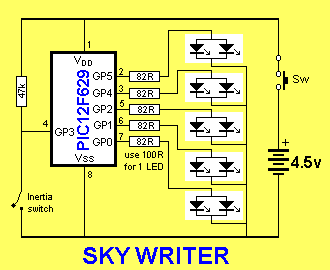
THE CIRCUIT
The circuit is very simple. All the work is done by the micro. We have
produced two different prototypes to show the effect using surface-mount
LEDs and super high-bright white LEDs with two LEDs per output and this
is really effective.
THE INERTIA SWITCH
There are two types of inertia switch. One is a weight on a spring and the other is a ball riding up an incline.
We have used both and they work equally-well and it's just a matter of which type you want to use.
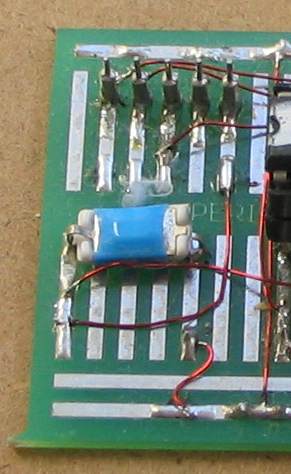
The ball hits the left-side of the
Inertia switch
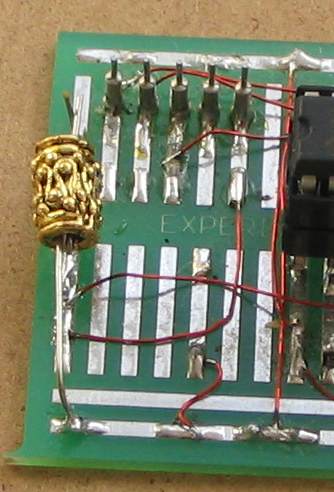
Close-up of the Inertia switch
showing the gap between the contacts.
When the project is moved quickly to the right, the contacts close.
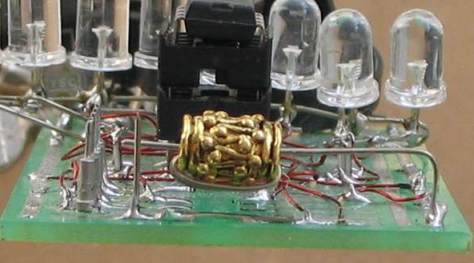
The weight is from a pack of metal
beads - from a bead shop.
To make the inertia switch yourself, it is a small ferrule on a wire. A length of tinned
copper wire wound around it and pulled tight and acts as a spring to keep
the
contacts open. These
contacts are connected to pin 4 of the microcontroller.
You can check the operation of this switch by connecting a LED and
resistor to the supply and waving the PC board. You will find the LED
illuminates at almost the exact same place "in space" making it an ideal
registration-mark for aligning the words.
Once you have a reliable starting-point for creating the display, you can make
almost any effect using the 5 LEDs. There are almost no limits as the display can
be 100
or more pixels long, and 5 pixels
high.
You can change the wording and add more features. To do this you need a
programmer and software. For details on this, see
Pick A
PIC Project.
The table we have used in the program occupies nearly all the space
available (for a table), however you can add other features by studying
some of our other projects.
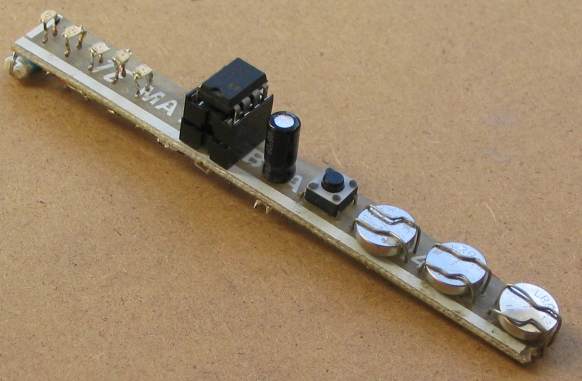 |
 Photos of the two prototypes
Photos of the two prototypes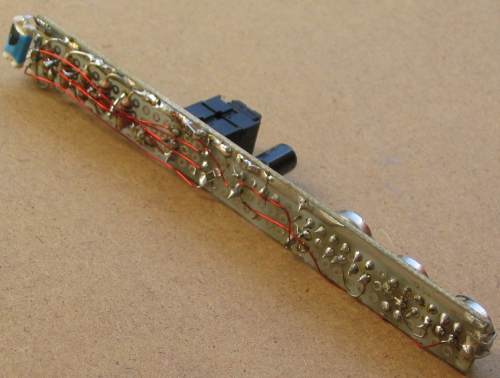 |
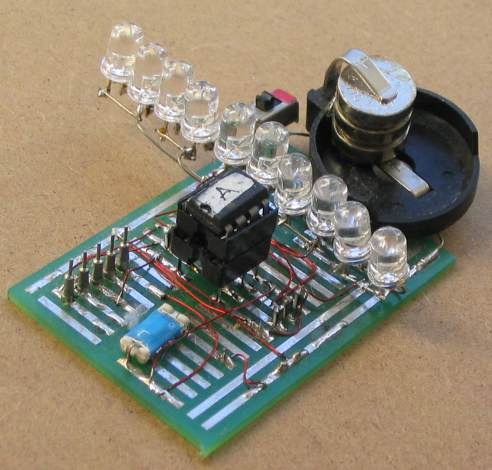 The circuit has two super high-bright LEDs on each output to give a very impressive display. The "inertia switch is shown as the blue rectangular component. It has a ball-bearing that hits both the top and bottom conductors (without jamming) when the ball rolls in one direction. The plastic molding prevents the ball touching both conductors when it rolls in the opposite direction. |
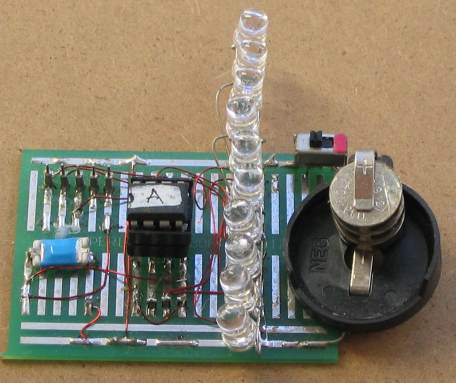 |
INSIDE THE CHIP
Inside the 8-pin PIC12F629, there are thousands of
transistors, diodes and resistors.
To make things simple, we can consider it has 5 main areas:
Firstly a column of 1024 locations where the program is stored. This
program is written by you and is
called the Program Area. It starts at address 000 to 3FF. The values in
these locations cannot be changed once the chip is "burnt."
The first 256 locations is the only area where a table can be located.
That's why your program uses only a few of these locations and sends the
micro to below the table for the rest of the program.
Another area has a column of 64 files, each capable of being loaded with 8
bits of information. These files are used by you to store information
during the running of the program and are called the User
Files. These Files (or Registers) start at 20h to 5F. The values in
these locations can be altered during the running of the program. The
information is lost when the power is removed.
The third area consists of files that have a special function and
hold bits of information for timers, overflow from an addition and lots
more. These are called Special Function Registers (FSR's).
These values can also be altered during the running of the program. The
information is lost when the power is removed.
There is one file in this list with a surprising feature. It is the
input/output port. It is file 05h. It is called the General Purpose
In/Out (GPIO) file or register or PORT. It has a number of driver
transistors that connect to pins 2 to 7 of the chip. These pins can be
configured as input or output lines with the capability of delivering
25mA to the outside world (pin 4 is an input only line). Then there is a
set of 128 locations in an area called the EEPROM. Information in
these files can be changed during the running of a program and is NOT
lost when the power is removed.
Then there is a microscopic computer that reads each instruction in the
program and carries out the task. Finally there is a working register, called "W," that gets loaded with a
value (called a literal). The Working register is the
transport medium to transfer values from one place to another.
There a lots more things inside the chip such as the program that allows
the chip to be "burnt" (flashed), the program that puts
information into the cells in the EEPROM area and more, but let's keep things simple.
The program you produce by hand is called assembly language and is written
in mnemonics. This produces a .asm file.
This is assembled by an assembler (MPASM - by Microchip) and produces a
.hex file. This file is used by a program called a "Programmer." The
Programmer sends the results to a piece of equipment connected to one of the ports of
your
computer and is called a "Burner." The burner has a socket and the chip
to be programmed
is fitted to the socket and "Burnt" or more-accurately "flashed" - in the
case of the 12F629. The 1024 spaces we mentioned above (and EEPROM) are filled with
your program and when the chip
is placed in a project and turned on, the program is read at the rate of
one million instructions per second by the internal "microscopic
computer."
An instruction can be a simple task such as placing a number (called a
literal) in the "working register" called register "W" or it can
be a more-complex task such as testing a bit in a file and jumping over
the next instruction if the bit is set.
The program for this project has been written by hand using the set of
35 instructions for the chip.
These instructions consists of letters and numbers, with
each letter taken from the first letter of a word such as Shift Left
File (slf) or Bit
Test File xx Skip if Set (btfss), etc.
Each instruction is called a mnemonic.
These are "half-computer,"
"half-English" instructions that both the human and micro understands.
A program for a PIC chip may look unusual at first, but the website
explains the terminology and takes you through
each stage in the development of an idea.
The memory size of 1024 locations (or instructions) may seem small by modern standards but you will find the
chip
is capable of taking the place of quite a number of "old-style"
gating chips and once you see what can be done, you will be designing
almost everything around a microcontroller.
One of the advantages of using a PIC microcontroller is the large amount
of back-up provided on the internet (see PIC Webring) and it has the ability to protect
a program by a feature called "Code
Protecting." By doing this during the burn process, no-one can read or copy the chip.
This gives you some hold over the contents of the program and a project can be
marketed.
If you like this concept, you are ready to start programming.
Writing a program is like writing a novel. You can do anything within
the capability of the chip, and to get some ideas, you can visit Talking
Electronics website for a list of projects created with a PIC12F629.
The next stage is to look at the program for the Sky
Writer and study the sub-routines.
Each sub-routine does a small task and by calling them in quick
succession the
result is very impressive.
If you want to change or improve the program, use our technique of
copy-and-paste where you change only a few instructions at a time.
This project offers three areas for experimentation. It shows how
interface external devices to a microcontroller.
It employs surface-mount technology and covers writing a program for
the simplest chip in the PIC series, the PIC12F629.
THE PROGRAM
Each letter or number to be displayed is made up of a matrix of dots.
All characters are five dots high and can be one dot wide or up to 7 or
more. Each column requires one byte (one location in memory) so some
letters require 7 bytes.
The program has two tables, called Table1 and tabale2. The first table
provides the values for each column of a Character as shown in the
diagram below.
You will notice the value 08 is not present in the left-hand listing
that shows the value for each row. This is due to the way we have used
the values in table1.
Each retlw in table1 contains 8 bits. We are only using 5 of these bits
for the characters. This means we have 3 bits available for other
purposes.
The lowest bit (bit0) is sent to GP0 and this turns on the lowest LED.
The next bit (bit1) turns on the next lowest LED and the next bit turns
on the 3rd LED from the bottom. Since GP3 is not an output pin, we
cannot use it for the display and so this bit is used in the main
program to see if an "end of character" is reached. In the table you
will see it has the value 08. This signifies an end of character. The
next bit (bit4) is used to turn on GP4 and the next bit (bit5) is used
to turn on GP5.
The next bit (bi6) has the value 40h and is used to detect "end of
word."
The highest bit (bit7) has the value 80h and is used to detect "end of
sentence."
Table2 holds the value for the beginning of a letter in table1. As you
can see, table2 contains the words of a sentence and the Main program
starts at the first value and then uses table1 to produce the letter. It
then advances down the table to produce the second letter etc.
In this way the letters are sent to the 5 LEDs to produce a word "in the
air."
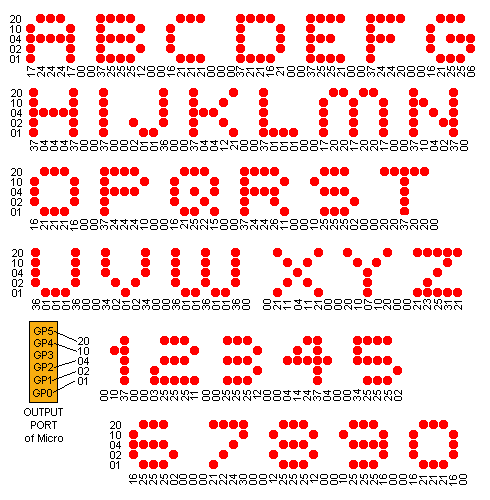
Going over this again:
The Main routine goes to table2, and finds the
starting point for a letter in table1.
A letter or number may consist of 1 to 7 columns.
Each column is
displayed for a short period, then the next byte is fetched and
the next column is displayed. In this way a letter or number
is shown on the display.
We can only show a maximum of 8 letters or numbers at a time as more
than this is difficult to read.
The PIC12F629 can only hold up to 256 table values in the first page of
program-memory. A table cannot be located anywhere else.
A few locations are lost at the beginning to send the micro down the
page to the fist sub-routine and all the remaining bytes hold table1 and
table2.
There is no more memory available for more sentences and if you can only
replace the two sentences with something else.
The program can be re-written to hold values in EEPROM where 256 bytes
are available and this is something you can consider. For
"cut-and-paste" instructions on writing and reading EEPROM, see
Dial Alarm-2 project.
You will also need to use some instructions in "set-Up." Using
EEPROM is very technical and the instructions we have used in Dial
Alarm-2 must be copied exactly.
If you want to buy a kit for Sky Writer, the chip comes pre-programmed with a number of sentences.
To change any of the content of the program you will need a
programmer and the software that drives the programmer as well as an
assembler (MPASM) .
All these things are covered in an article:
Pick A
PIC Project.
CONSTRUCTION
A full kit of components is available from
Talking Electronics. It contains
a
pre-programmed chip and surface mount components as well as through-hole
components.
At the moment, surface mount components are not available individually
from electronics supplies and a kit is the best way to get into this
area of construction.
The first components to fit are the surface-mount resistors. The kit
comes with a length of very fine solder and this will make soldering
very easy provided you have a fine tipped soldering iron.
Tin one of the square lands with a very small amount of solder and place
a resistor in position. Hold it in place with a small
Jeweler's screwdriver, by pushing down firmly. Heat up the end
that has been pre-tinned and the resistor will sit on the board.
Now solder the other end very quickly. Let the resistor
cool and go back to the first end.
Repeat this will all the other resistors and the 100n capacitor.
Push the LEDs through the holes until they touch the PC board. Make sure
the shorter lead goes to the negative rail.
Solder the leads very quickly as LEDs are temperature-sensitive.
Fit the IC socket and electrolytic.
The three button cells are fitted to the board by fabricating battery
holders from very fine tinned copper wire contained in the kit.
Firstly solder the two negative contacts by looping the wire through the
board and soldering one end. Now pull the wire with pliers and solder
the other end. Loop the positive wire through the board and solder one
end. Fit the cell under the wire, so it touches the negative wires on
the board, pull the loop tight with pliers and
solder the other end. Solder the other positive wire and the cell will
be kept in position. Repeat the process for the other two cells.
Finally, make the inertia switch as described above.
Move the contacts together so they are separated by a very small gap.
Fit the microcontroller to the socket and the project is complete.
Move the project quickly in a broad arc and a message will appear "in
the air."
GOING FURTHER
How many times have you searched for a birthday or anniversary card and
found nothing to be suitable? Either the message or the pictures are not
appropriate or the music and flashing lights are not "quality."
Most of the time I buy a blank embossed card and fill it out myself.
There is an enormous market for well-designed cards at a reasonable
price.
This project can be made very small and flat and added to a
card so it can been seen in the shop. It could be added to a birthday card or "Get Well"
card and include a simple game or message that displays randomly each
time the card is "waved."
The project needs to be converted to surface mount and the
micro could be a COB (Chip On Board) - as a tiny dob of resin on
mass produced items.
This project is just one idea for a range of cards that are "different from the
rest." The card market is enormous and when you realise most cards
are poorly designed, you have a goldmine of potential.
Other ideas are a combination-lock game, a counter, a ladder
game, and similar things that would make buying a card a
rewarding decision.
Cards are just one area. The market is enormous and include toys and
gimmicks combined with sweets.
The PIC micro gets an idea "off the ground" and you can get your ideas into
production very easily.
It's the starting point you have always wanted.
PARTS
LIST |
|
5 - 82R or 100R
surface-mount resistors 1 - 47k surface-mount resistor "103" 5 - 3mm or 5mm red or white LEDs 1 - 8 pin IC socket 1 - pre-programmed PIC12F629 IC "SKY" 1 - 30cm thick tinned copper wire 1 - 40cm 0.2mm enamelled wire 1 - weight for inertia switch 3 - button cells from 12v lighter battery 1 - 1m very fine solder 1 - Sky Writer PCB |
Here are the files:
SkyWriter.asm
SkyWriter.hex
;Sky12F629.asm
;Sky writer with 5 LEDs for PIC12F629 13-5-2010
list p=12F629
radix dec
include "p12f629.inc"
errorlevel -302 ; Don't complain about BANK 1 registers
__CONFIG _INTRC_OSC_NOCLKOUT & _MCLRE_OFF & _WDT_OFF
& _PWRTE_ON & _BODEN_OFF & _CP_OFF & _CPD_OFF ;Internal osc.
; globals
fileA equ 20h
fileB equ 21h
fileC equ 22h
jump1 equ 23h
jump2 equ 24h
counter equ 27h
jump2_savd equ 28h
counter2 equ 29h
status equ 03h
option_reg equ 81h
; bits on GPIO
pin7 equ 0 ;GP0
pin6 equ 1 ;GP1
pin5 equ 2 ;GP2
pin4 equ 3 ;GP3 input only
pin3 equ 4 ;GP4
pin2 equ 5 ;GP5
;bits
rp0 equ 5
Start org 0x00 ;program starts at location 000
goto SetUp
table1 ;characters
ADDWF 02h,1 ;add W to Program Counter
retlw 00
retlw 17h ;A - jump value = 01h
retlw 24h
retlw 24h
retlw 24h
retlw 17h
retlw 08h
retlw 37h ;B - jump value = 07h
retlw 25h
retlw 25h
retlw 25h
retlw 12h
retlw 08h
retlw 34h ;C - jump value = 0Dh
retlw 16h
retlw 21h
retlw 21h
retlw 21h
retlw 08h
retlw 37h ;D - jump value = 13h
retlw 21h
retlw 21h
retlw 21h
retlw 16h
retlw 08h
retlw 37h ;E - jump value = 19h
retlw 25h
retlw 25h
retlw 21h
retlw 08h
retlw 37h ;F - jump value = 1Eh
retlw 24h
retlw 24h
retlw 20h
retlw 08h
retlw 16h ;G - jump value = 23h
retlw 21h
retlw 25h
retlw 25h
retlw 06h
retlw 08h
retlw 37h ;H - jump value = 29h
retlw 04h
retlw 04h
retlw 04h
retlw 37h
retlw 08h ;I - jump value = 2Eh
retlw 37h
retlw 08h
retlw 02h ;J - jump value = 31h
retlw 01h
retlw 01h
retlw 36h
retlw 08h
retlw 37h ;K - jump value = 36h
retlw 04h
retlw 04h
retlw 12h
retlw 21h
retlw 08h
retlw 37h ;L - jump value = 3Ch
retlw 01h
retlw 01h
retlw 01h
retlw 08h
retlw 17h ;M - jump value = 41h
retlw 20h
retlw 20h
retlw 17h
retlw 20h
retlw 20h
retlw 17h
retlw 08h
retlw 37h ;N - jump value = 49h
retlw 10h
retlw 04h
retlw 02h
retlw 37h
retlw 08h
retlw 16h ;O - jump value = 4Fh
retlw 21h
retlw 25h
retlw 23h
retlw 17h
retlw 08h
retlw 37h ;P - jump value = 55h
retlw 24h
retlw 24h
retlw 10h
retlw 08h
retlw 16h ;Q - jump value = 5Ah
retlw 21h
retlw 25h
retlw 23h
retlw 17h
retlw 08h
retlw 37h ;R - jump value = 60h
retlw 24h
retlw 24h
retlw 26h
retlw 11h
retlw 08h
retlw 10h ;S - jump value = 66h
retlw 25h
retlw 25h
retlw 25h
retlw 02h
retlw 08h
retlw 20h ;T - jump value = 6Ch
retlw 20h
retlw 37h
retlw 20h
retlw 20h
retlw 08h
retlw 36h ;U - jump value = 72h
retlw 01h
retlw 01h
retlw 01h
retlw 36h
retlw 08h
retlw 34h ;V - jump value = 78h
retlw 02h
retlw 01h
retlw 02h
retlw 34h
retlw 08h
retlw 36h ;W - jump value = 7Eh
retlw 01h
retlw 01h
retlw 36h
retlw 01h
retlw 01h
retlw 36h
retlw 08h
retlw 21h ;X - jump value = 86h
retlw 11h
retlw 04h
retlw 11h
retlw 21h
retlw 08h ;program looks for 08h as end of character
retlw 20h ;Y - jump value = 8Ch
retlw 10h
retlw 07h
retlw 10h
retlw 20h
retlw 08h ;program looks for 08h as end of character
retlw 21h ;Z - jump value = 92h
retlw 23h
retlw 04h
retlw 31h
retlw 21h
retlw 08h ;program looks for 08h as end of character
retlw 00h ;empty space x 2 columns - jump value = 98h
retlw 00h
retlw 08h ;program looks for 08h as end of character
retlw 34h ;comma - jump value = 9Bh
retlw 08h ;program looks for 08h as end of character
retlw 10h ;1 - jump value = 9Dh
retlw 37h
retlw 08h
retlw 03h ;2 - jump value = A0h
retlw 25h
retlw 25h
retlw 25h
retlw 11h
retlw 08h
retlw 25h ;3 - jump value = A6h
retlw 25h
retlw 25h
retlw 12h
retlw 08h
retlw 04h ;4 - jump value = ABh
retlw 14h
retlw 24h
retlw 37h
retlw 04h
retlw 08h
retlw 34h ;5 - jump value = B1h
retlw 25h
retlw 25h
retlw 25h
retlw 02h
retlw 08h
retlw 16h ;6 - jump value = B7h
retlw 25h
retlw 25h
retlw 25h
retlw 02h
retlw 08h
retlw 21h ;7 - jump value = BDh
retlw 22h
retlw 24h
retlw 30h
retlw 08h
retlw 12h ;8 - jump value = C2h
retlw 25h
retlw 25h
retlw 25h
retlw 12h
retlw 08h
retlw 10h ;9 - jump value = C8h
retlw 25h
retlw 25h
retlw 25h
retlw 16h
retlw 08h
;0 - use jump value = 4Fh
table2 ;words
ADDWF 02h,1 ;add W to Program Counter
retlw 29h ;H - Jump1 value for H in table1
retlw 01h ;A
retlw 78h ;V
retlw 19h ;E
retlw 40h ;program looks for 40h as end of word
retlw 98h ;empty space
retlw 01h ;A
retlw 40h ;program looks for 40h as end of word
retlw 23h ;G
retlw 60h ;R
retlw 19h ;E
retlw 01h ;A
retlw 6Ch ;T
retlw 40h ;program looks for 40h as end of word
retlw 13h ;D
retlw 01h ;A
retlw 8Ch ;Y
retlw 40h ;program looks for 40h as end of word
retlw 00h ;0
retlw 80h ;program looks for 80h as end of SENTENCE
retlw 6Ch ;T - Jump1 value for H in table1
retlw 60h ;R
retlw 8Ch ;Y
retlw 40h ;program looks for 40h as end of word
retlw 66h ;S
retlw 4Fh ;O
retlw 41h ;M
retlw 19h ;E
retlw 6Ch ;T
retlw 29h ;H
retlw 2Eh ;I
retlw 49h ;N
retlw 23h ;G
retlw 40h ;program looks for 40h as end of word
retlw 49h ;N
retlw 19h ;E
retlw 7Eh ;W
retlw 40h ;program looks for 40h as end of word
retlw 00h ;0
retlw 80h ;program looks for 80h as end of SENTENCE
;Delays
Del_1 movlw 01h
movwf fileB
DelX decfsz fileA,1 ; ,1 denotes the result of the decrement
goto DelX
decfsz fileB,1 ; is placed in the file
goto DelX
retlw 00
Del_2 movlw 0F0h
movwf fileA
DelY decfsz fileA,1
goto DelY
retlw 00
Del_3 movlw 040h
movwf fileB
DelZ decfsz fileA,1 ; ,1 denotes the result of the decrement
goto DelZ
decfsz fileB,1 ; is placed in the file
goto DelZ
retlw 00
Del_4 movlw 040h
movwf fileC
Del4A decfsz fileA,1 ; ,1 denotes the result of the decrement
goto Del4A
decfsz fileB,1 ; is placed in the file
goto Del4A
decfsz fileC,1
goto Del4A
retlw 00
SetUp bsf status, rp0 ;Bank 1
movlw b'10000110' ;Turn off T0CKI
movwf option_reg
movlw 07h ;Set up W to turn off Comparator
movwf CMCON
movlw b'00001000' ;Set GP0,1,2,4,5, as output
movwf TRISIO ;enable outputs
bcf status, rp0 ;bank 0
clrf GPIO ;Clear GPIO of junk
Main movlw 03h
movwf counter2 ;each sentence will appear 3 times
movlw 04h ;each word will appear for 4 "waves"
movwf counter
MainA clrf jump2_savd ;for table2
MainB movf jump2_savd,0
movwf jump2
btfsc GPIO,3 ;looking for close of inertia switch
goto MainB
call Del_3
call Del_3
Main1 movf jump2,0 ;move table2 jump-value into W
call table2
movwf jump1 ;put the hex value of the letter into jump1
xorlw 80h ;see if end of sentence is reached in table2
btfsc 03,2 ;bit 2 of file 3 will be SET (=1)
goto Main5
movf jump2,0 ;move table2-jump value into W
call table2
xorlw 40h ;see if end of word is reached in table2
btfsc 03,2 ;bit 2 of file 3 will be SET (=1)
goto Main3 ;end of word - add a delay
Main2 movf jump1,0 ;put column-value into W
call table1
movwf GPIO ;display column value
xorlw 08h ;see if end of character is reached
btfsc 03,2 ;bit 2 of file 3 will be SET (=1)
goto Main4
call Del_1 ;creates the width of the dot
clrf GPIO
call Del_2 ;creates the space between the dots
incf jump1,1
goto Main2
Main3 call Del_3
decfsz counter,1
goto MainB
incf jump2,0
movwf jump2_savd
movlw 04h
movwf counter
goto MainB
Main4 call Del_1 ;space between the letters
call Del_1
call Del_1
incf jump2,1
goto Main1
Main5 decfsz counter2,1
goto MainA
incf jump2,0
movwf jump2_savd
movlw 03h
movwf counter2
goto MainB
;oscillator calibration
org 3ffh
movwf OSCCAL
end
|
20/5/2010